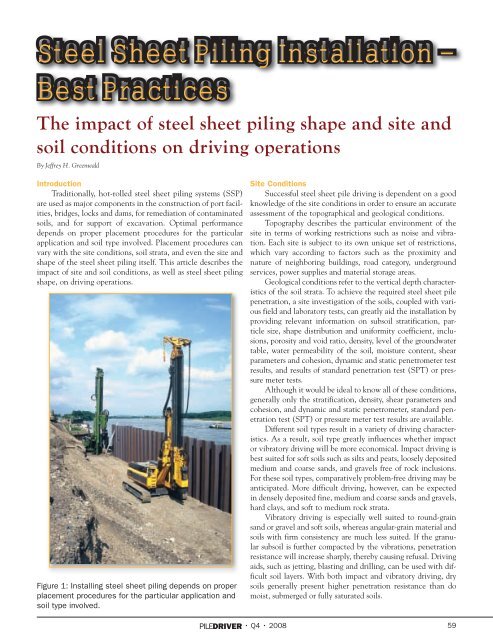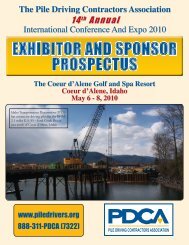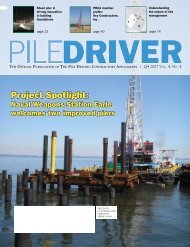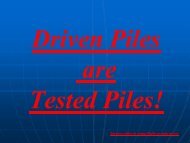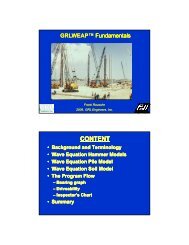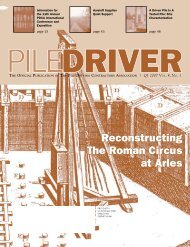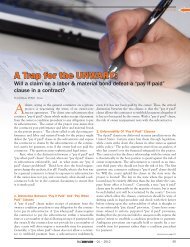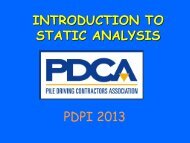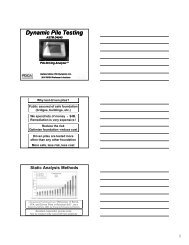Downloads - Pile Driving Contractors Association
Downloads - Pile Driving Contractors Association
Downloads - Pile Driving Contractors Association
You also want an ePaper? Increase the reach of your titles
YUMPU automatically turns print PDFs into web optimized ePapers that Google loves.
Steel Sheet Piling Installation –<br />
Best Practices<br />
The impact of steel sheet piling shape and site and<br />
soil conditions on driving operations<br />
By Jeffrey H. Greenwald<br />
Introduction<br />
Traditionally, hot-rolled steel sheet piling systems (SSP)<br />
are used as major components in the construction of port facilities,<br />
bridges, locks and dams, for remediation of contaminated<br />
soils, and for support of excavation. Optimal performance<br />
depends on proper placement procedures for the particular<br />
application and soil type involved. Placement procedures can<br />
vary with the site conditions, soil strata, and even the size and<br />
shape of the steel sheet piling itself. This article describes the<br />
impact of site and soil conditions, as well as steel sheet piling<br />
shape, on driving operations.<br />
Figure 1: Installing steel sheet piling depends on proper<br />
placement procedures for the particular application and<br />
soil type involved.<br />
Site Conditions<br />
Successful steel sheet pile driving is dependent on a good<br />
knowledge of the site conditions in order to ensure an accurate<br />
assessment of the topographical and geological conditions.<br />
Topography describes the particular environment of the<br />
site in terms of working restrictions such as noise and vibration.<br />
Each site is subject to its own unique set of restrictions,<br />
which vary according to factors such as the proximity and<br />
nature of neighboring buildings, road category, underground<br />
services, power supplies and material storage areas.<br />
Geological conditions refer to the vertical depth characteristics<br />
of the soil strata. To achieve the required steel sheet pile<br />
penetration, a site investigation of the soils, coupled with various<br />
field and laboratory tests, can greatly aid the installation by<br />
providing relevant information on subsoil stratification, particle<br />
size, shape distribution and uniformity coefficient, inclusions,<br />
porosity and void ratio, density, level of the groundwater<br />
table, water permeability of the soil, moisture content, shear<br />
parameters and cohesion, dynamic and static penetrometer test<br />
results, and results of standard penetration test (SPT) or pressure<br />
meter tests.<br />
Although it would be ideal to know all of these conditions,<br />
generally only the stratification, density, shear parameters and<br />
cohesion, and dynamic and static penetrometer, standard penetration<br />
test (SPT) or pressure meter test results are available.<br />
Different soil types result in a variety of driving characteristics.<br />
As a result, soil type greatly influences whether impact<br />
or vibratory driving will be more economical. Impact driving is<br />
best suited for soft soils such as silts and peats, loosely deposited<br />
medium and coarse sands, and gravels free of rock inclusions.<br />
For these soil types, comparatively problem-free driving may be<br />
anticipated. More difficult driving, however, can be expected<br />
in densely deposited fine, medium and coarse sands and gravels,<br />
hard clays, and soft to medium rock strata.<br />
Vibratory driving is especially well suited to round-grain<br />
sand or gravel and soft soils, whereas angular-grain material and<br />
soils with firm consistency are much less suited. If the granular<br />
subsoil is further compacted by the vibrations, penetration<br />
resistance will increase sharply, thereby causing refusal. <strong>Driving</strong><br />
aids, such as jetting, blasting and drilling, can be used with difficult<br />
soil layers. With both impact and vibratory driving, dry<br />
soils generally present higher penetration resistance than do<br />
moist, submerged or fully saturated soils.<br />
• Q4 • 2008<br />
59


